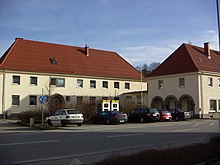German earthworks and stone works
The German Earth and Stone Works GmbH ( DEST ) were a company incorporated on 29 April 1938 Company of the SS , which the Reich leader SS Heinrich Himmler was subordinate. DEST used forced labor for concentration camp prisoners to produce building materials for, for example, guide buildings .
prehistory
From around 1936 Adolf Hitler began to plan large-scale Führer buildings . These should not only be built in the capital Berlin, but also in other cities. For Hamburg, for example, the construction of a large bridge as well as a KdF hotel and a 250 m high Gauhaus were planned. Hitler's favorite Albert Speer was entrusted with the supervision of these government projects. The building material was supposed to be produced by concentration camp inmates. Production was included in the four-year plan.
The early concentration camps of 1933–1934 were used to imprison political enemies. After the new government was consolidated, new camps were to serve an additional purpose. The participation of concentration camp prisoners in the planned Führerbauten meant a renewed increase in power for Himmler. Himmler, to which the SS were subordinate, had new concentration camps built, the location of which was based on suitable terrain.
The concentration camp inspection (IKL) did not choose the location of a concentration camp in Thuringia, which was later to be named Buchenwald , by chance. The IKL, which was subordinate to Himmler, commissioned the Geological Institute Jena on April 24, 1937 to locate an area with brick clay, since concentration camp prisoners were supposed to make bricks.
founding
A year later, on April 29, 1938, the SS founded Deutsche Erd- und Steinwerke GmbH . Oswald Pohl headed DEST and was entrusted with the production of building materials. Speer granted DEST a loan of 9.5 million Reichsmarks . The loan should be paid off within 10 years through the delivery of building materials. The DEST leased quarries near Mauthausen and Flossenbürg, and the ICL had concentration camps built there. Brickworks were built near Sachsenhausen, Buchenwald and Neuengamme.
The DEST maintained quarries, granite works, brick works, gravel works and building material works in the immediate vicinity of the concentration camp. This is how the Flossenbürg (1938), Mauthausen (1938, granite), Gusen (1938, granite) and Auschwitz camps came into being .
The Groß-Rosen camp , which was established in Silesia in 1940, was located next to a quarry with high-quality granite, in which Speer was particularly interested. Also Natzweiler was made in 1940 near a quarry, as Speer wanted to use those red granite.
working conditions
The working conditions of the prisoners who were driven into forced labor were catastrophic and guided by the principle of annihilation through labor .
From 1943 onwards, the SS had primarily armaments production in these plants.
Work group St. Georgen an der Gusen (Granitwerke Mauthausen)
The work group St. Georgen an der Gusen ( Granitwerke Mauthausen ) was one of the most important groups of works of DEST . In addition to the quarries in the vicinity of the Gusen and Mauthausen concentration camps towards the end of the war under the code name B8 Bergkristall , it also operated the largest underground production plant for Messerschmitt Me 262 jet fighter planes in St. Georgen an der Gusen, Austria . Mention should also be made of an extensive collaboration between the St. Georgen group of works in the years 1943–1945 with Steyr Daimler Puch .
The “Gusen”, “Kastenhof” and “Wienergraben” companies were confiscated from the Soviet Union as German property after the end of the war, together with the administrative headquarters in St. Georgen an der Gusen . While the "Wienergraben" operation was soon added to the Mauthausen Memorial, the quarry operations in Gusen under the name "Granitwerke Gusen" continued to be operated by the Soviet USIA as a Soviet state enterprise until 1955. Individual objects and properties that were not claimed by the Soviets were "restored" by Austrian courts as early as 1948. From 1955 the Republic of Austria finally entered into the remaining former German property of the DEST work group St. Georgen an der Gusen. The “Public Administration of Deutsche Erd- und Steinwerke GmbH Berlin” set up by the Republic of Austria existed until the end of the 1960s.
literature
- Jan Erik Schulte : Forced Labor and Extermination. The economic empire of the SS. Oswald Pohl and the SS-Wirtschafts-Verwaltungshauptamt 1933–1945. Paderborn 2001, ISBN 3-506-78245-2 .
- Markus Wicke: SS and DRK. The Presidium of the German Red Cross in the nationalist system of rule 1937–1945 . Self-published, Potsdam 2002, ISBN 3-8311-4125-8 , p. 64 .
- Enno Georg: The economic enterprises of the SS (= series of the quarterly books for contemporary history . No. 7 ). Deutsche Verlags-Anstalt, 1965, ISSN 0506-9408 , Chapter 3.
See also
- List of listed objects in St. Georgen an der Gusen
- List of listed objects in Langenstein (Upper Austria)
Footnotes
- ↑ On February 2, 1938, Hitler boasted to Schuschnigg that the largest bridge in the world was being built in Hamburg and that the USA should see that Germany was being built more beautifully and bigger. - In: Kurt von Schuschnigg: Requiem in red-white-red , notes of the prisoner Dr. Auster, Prague 1947, p. 66.
- ^ Stanislav Zámečník: (Ed. Comité International de Dachau): That was Dachau. Luxemburg, 2002, p. 81. ISBN 2-87996-948-4
- ↑ Zámečník, p. 81.
- ^ Rudolf A. Haunschmied , Jan-Ruth Mills, Siegi Witzany-Durda: St. Georgen-Gusen-Mauthausen - Concentration Camp Mauthausen Reconsidered . BoD, Norderstedt 2008, ISBN 978-3-8334-7440-8 . P. 45ff
